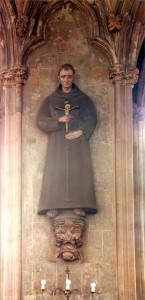
Eustace Chapuys, the imperial ambassador, recorded their expulsion in a letter to Charles V, Holy Roman Emperor:
“All the Minor Observant friars of this kingdom have been expelled from their convents, owing to their having refused to take the oath against the authority of the Apostolic See. They have, moreover, been distributed among the several convents in the provinces, where they are locked up, put in chains, and worse treated than if they were prisoners; indeed they would much prefer being in irons than in the hands of those under whose power they now are.”1
A document in Letters and Papers, records “Nomina eorumdem Observantium defunctorum”, i.e. the names of the Observant Friars who died soon after:
“John Spens died at London; also Thos. Artte, Thos. Kellam, Jeremy Manson, John Kinge, John Kyxe and Nic. Harfforthe. Judocus Asterdam died at Canterbury; Andrew Danolde at Greenwich; John Scryvner at Reading; also Ant. Lenes. Alex. Hyll died in patria; Theodoric Barkham at Greenwich; James Wylyamson at Colchester; Cornelius Symondys in patria; also Edw. Pope and John Biltone. Wm. Ellell at Dancaster. Gerard Dyryson in patria. John Martyne at Newcastle. Rob. Bynkys at Reading. Fras. Caro at Bristol. Hen. Heltryne in patria; also Adrian Dehohe, Thos. Danyell and Fras. Carre. Lewis Wylkynson at Canterbury. Bryan Fysshborne at Yarmouth. Wm. Hasarde at Dunwyche. John Wells at Ipswich. Robt. Bakare at Doncaster.”2
That’s 31 names!
There are also records of those who went into exile, those who moved to other places in England and those who were recorded as “exemptorum”, or exempt.
In “The observant friars of Greenwich”, in A History of the County of Kent, which draws on contemporary aacounts, it says:
“On 17 June two cart-loads of friars drove through London to the Tower, and it is possible that some of the Greenwich Observants were among them. On or before 11 August the friars were expelled from their convent (though they seem to have made some kind of submission) and distributed in different places, generally in houses of the Grey Friars, where, wrote Chapuys to Charles V, ‘they were locked up in chains and treated worse than they could be in prison.’ Some, such as John Forest, were actually in prison in London. Two of them, inclosed in a poor lodging at the Grey Friars, Stamford, and treated as prisoners, were ‘in meetly good case as the world at this time requireth,’ and sent to London for their little belongings, including a new Psalter, a pair of socks, a penner and inkhorn. But the severity of their treatment is shown by the fact that out of 140 Observant Friars thirty-one soon died, and this does not account for all the deaths. Thomas Bourchier, who was a member of the Greenwich friary in the reign of Mary, gives details of several martyrdoms which probably belong to this time, though the writer assigns them to 1537. On 19 July Anthony Brdrbe [Brockby/ Browne?], formerly of Magdalen College, Oxford, a distinguished scholar, who had been imprisoned and tortured to such an extent that ‘ for twenty-five days he could not turn in bed or lift his hands to his mouth,’ was strangled with his own cord. On 27 July Thomas Cortt, who had been imprisoned for a sermon against the king in the church of St. Lawrence, London, died in Newgate. On 3 August Thomas Belchiam, a young priest, who had composed a book against the king, one copy of which he left in the hands of his brethren at Greenwich, died of starvation in Newgate. No mention of these three friars occurs in extant contemporary authorities, but Bourchier’s account representing the tradition of the Order is probably substantially correct, though the names may be misspelt.”3
The account goes on to tell what happened to Friar John Forest, who had acted as confessor to Catherine of Aragon and who “organized the opposition to the king in the provincial chapter”. It states:
“From his prison he had written to Catherine of Aragon in expectation of immediate death, probably in 1534; he was then sixty-four years of age, and had spent forty-three of these in religion. He was, however, transferred to the Grey Friars, London, in consequence probably of having made his submission. At the Grey Fliars he enjoyed considerable liberty; from well-wishers he received small sums of money for fuel and other necessaries, and was allowed to celebrate mass and hear confessions. Suspicion arising, Forest was cast into Newgate, and in examination admitted that he induced men in confession ‘ to hold and stick to the old fashion of belief.’ On 22 May, 1538, he was roasted alive as a traitor and heretic.”
In her will, Catherine of Aragon left instructions for her remains to “be buried in a convent of Observant Friars” but the dissolution of the monasteries meant that by the time of her death in January 1536 there were no monasteries of Observant Friars left. How sad.
Of course, the Observant Friars were not the only order to suffer Henry VIII’s wrath, you can read all about the Carthusian monks in my article over at the Tudor Society – click here.
Notes and Sources
- Calendar of State Papers, Spain, Volume 5 Part 1, 1534-1535, 86.
- Letters and Papers, Foreign and Domestic, Henry VIII, Volume 7, 1534, Miscellaneous, 1607.
- ‘Friaries: The observant friars of Greenwich’, in A History of the County of Kent: Volume 2, ed. William Page (London, 1926), pp. 194-198 http://www.british-history.ac.uk/vch/kent/vol2/pp194-198 [accessed 16 July 2015].